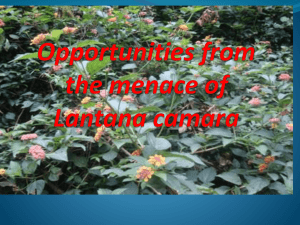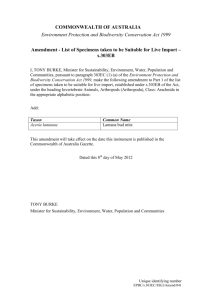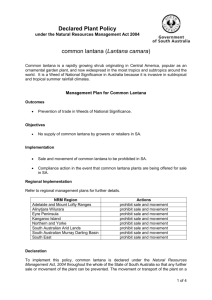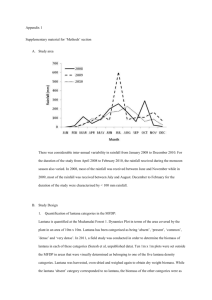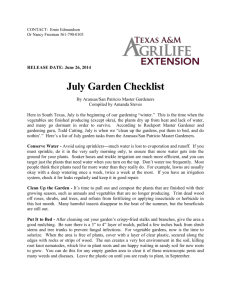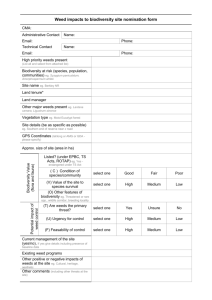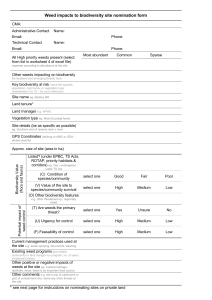Threatened Species Nomination Form
advertisement
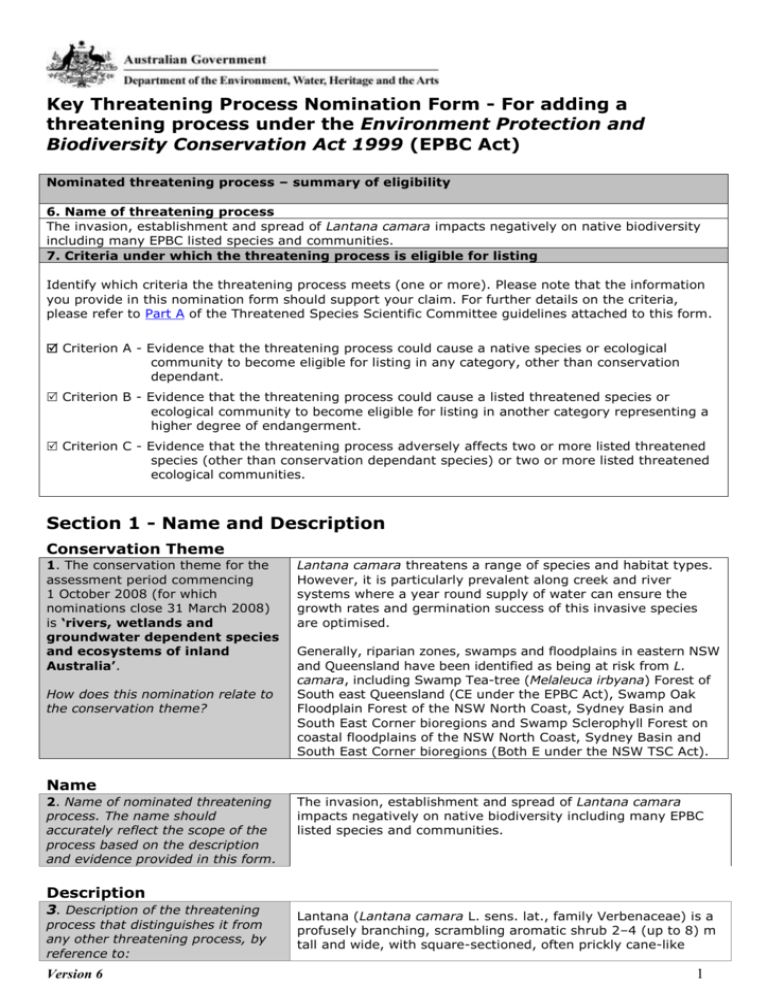
Key Threatening Process Nomination Form - For adding a threatening process under the Environment Protection and Biodiversity Conservation Act 1999 (EPBC Act) Nominated threatening process – summary of eligibility 6. Name of threatening process The invasion, establishment and spread of Lantana camara impacts negatively on native biodiversity including many EPBC listed species and communities. 7. Criteria under which the threatening process is eligible for listing Identify which criteria the threatening process meets (one or more). Please note that the information you provide in this nomination form should support your claim. For further details on the criteria, please refer to Part A of the Threatened Species Scientific Committee guidelines attached to this form. Criterion A - Evidence that the threatening process could cause a native species or ecological community to become eligible for listing in any category, other than conservation dependant. Criterion B - Evidence that the threatening process could cause a listed threatened species or ecological community to become eligible for listing in another category representing a higher degree of endangerment. Criterion C - Evidence that the threatening process adversely affects two or more listed threatened species (other than conservation dependant species) or two or more listed threatened ecological communities. Section 1 - Name and Description Conservation Theme 1. The conservation theme for the assessment period commencing 1 October 2008 (for which nominations close 31 March 2008) is ‘rivers, wetlands and groundwater dependent species and ecosystems of inland Australia’. How does this nomination relate to the conservation theme? Lantana camara threatens a range of species and habitat types. However, it is particularly prevalent along creek and river systems where a year round supply of water can ensure the growth rates and germination success of this invasive species are optimised. Generally, riparian zones, swamps and floodplains in eastern NSW and Queensland have been identified as being at risk from L. camara, including Swamp Tea-tree (Melaleuca irbyana) Forest of South east Queensland (CE under the EPBC Act), Swamp Oak Floodplain Forest of the NSW North Coast, Sydney Basin and South East Corner bioregions and Swamp Sclerophyll Forest on coastal floodplains of the NSW North Coast, Sydney Basin and South East Corner bioregions (Both E under the NSW TSC Act). Name 2. Name of nominated threatening process. The name should accurately reflect the scope of the process based on the description and evidence provided in this form. The invasion, establishment and spread of Lantana camara impacts negatively on native biodiversity including many EPBC listed species and communities. Description 3. Description of the threatening process that distinguishes it from any other threatening process, by reference to: Version 6 Lantana (Lantana camara L. sens. lat., family Verbenaceae) is a profusely branching, scrambling aromatic shrub 2–4 (up to 8) m tall and wide, with square-sectioned, often prickly cane-like 1 (i) its biological and non-biological components; (ii) the processes by which those components interact (if known). stems (Swarbrick et al. 1995). L. camara is an 'aggregate species', or 'species complex', of which there are some 650 hybrid varieties in over 60 countries world-wide (Howard, 1969; Parsons & Cuthbertson, 2001). This diverse range of varieties stem from several natural variants of L. camara across its presumed native range in the tropical Americas. In Australia at least 29 wild, cultivated and hybridised varieties have been identified. There are three major processes via which Lantana threatens biodiversity and ecosystem function in Australia. These are competition for habitat and resources; smothering; and prevention of recruitment thereby preventing the natural succession and recovery of native ecosystems. Sclerophyll woodlands, sclerophyll forests, rainforests and dry rainforests are all susceptible to Lantana establishment (Driscoll and Quinland 1985; Lamb 1988; Fensham et al 1994; Gentle and Duggin 1997a). Lantana will readily invade undisturbed sites and communities with open canopies. Lantana can also block succession following a disturbance, by out-competing native colonisers and thereby preventing natural recovery and decreasing biodiversity. Fensham et al. (1994) document declines in plant species richness with increasing levels of Lantana infestation in dry rainforest. Accumulation of heavy fuel loads along boundaries between savanna woodland and dry rainforest is also documented, encouraging fire and leading to significant canopy loss and edge erosion in the latter. Typically, Lantana then dominates the area of lost dry rainforest, rendering it prone to further fires. Alcova (1987) established a large decline (at least 70%) in inferred recruitment (being the number of native tree and shrub saplings present) in Lantana-infested areas of eucalypt woodland compared to Lantana-free areas. The generally suppressive effect of Lantana on a wide range of native species is attested by several studies (Gentle and Duggin 1998, Day et al. 2003) and a multitude of field observations. Swarbrick et al. (1995), citing observations by Driscoll and Quinlan (1985) that “eucalypt seedlings generally fail to establish under Lantana”, infers inhibition of germination through lack of light. Webb et al. (1972) reports Lantana blocking the succession of rainforest species for some 15 years in an artificially created (1957) gap in intact rainforest, and Stock (2004) affirms that the site was still Lantana-dominated in 2004. Lantana is also allelopathic, i.e. able to inhibit or suppress by chemical means the germination and/or growth of at least some competing plant species. Overseas glasshouse studies (Swarbrick et al. 1995; Day et al. 2003) and a substantive Australian field trial (Gentle and Duggin 1997b), provide support for this. It is suggested that Lantana may also change soil microhabitat through shading, self-mulching, and altered water and nutrient balances. Lamb (1988, cited in Swarbrick et al. 1995) identified an increase in soil nitrate in eucalypt woodland and a decline in other nutrients following Lantana invasion, to the benefit of the Lantana and other weeds, and to the detriment of some native species. Gentle and Duggin (1998) point to Lantana’s ability to out-compete for and sequester surface-soil nutrients, such as are made available by disturbance episodes, and verified experimentally Lantana’s ability to out-compete and suppress an analogous native coloniser of mesic forests (Choricarpia leptopetala, Myrtaceae). Lantana dominance is also likely to adversely affect the richness of some soil faunal assemblages. Cummings (2004) reports a reduced presence in Lantana-dominated vegetation of several functional groups of ant species, compared to adjacent ‘natural’ Version 6 2 (rainforest and sclerophyll) communities, and concludes this probably relates both to initial disturbance events and to the structure of Lantana-dominated vegetation that followed. Overseas research (Fernandes et al. 2001) points to a progressive loss of diversity among mycorrhizal arbuscular fungi in rainforest systems of Madagascar, correlated with a loss of vascular plant diversity and non-autochthonous secondary successions including Lantana camara-dominated associations. Lantana is not established as a causal mechanism but the ability of Lantana to arrest vegetation succession for decades (e.g. Lamb 1994, apropos subtropical rainforest), and to inhibit growth of at least some microorganisms (Parsons and Cuthbertson 2001), suggests it may also inhibit mycorrhizal recolonisation. Interactions between Lantana invasion and the presence of disturbance factors such as feral animals, human mediated disturbance, edge effects or extreme weather events causing canopy openings are also significant. For example, Fensham et al (1994) postulated a probable role in dry rainforest for feral pigs causing initial canopy openings that allow Lantana establishment. Pigs then avoid dense Lantana thickets, causing further openings in intact forest. The resulting Lantana thickets then, in this case, promote intense fire. Without the added impact of Lantana invasion, the initial disturbance events are unlikely to be significant enough to constitute a major threat to biodiversity in the region. The important factor that distinguishes Lantana’s impacts from other threatening processes is the magnitude of its current and potential impacts. Within this current distribution range, research indicates Lantana threatens 139 native plant species; 24 native animal species; and ten ecological communities currently listed under the EPBC Act. Analysis of the data associated with these species shows that 61 Vulnerable plant species and two Vulnerable animal species are likely to become listed as Endangered; 50 Endangered plant species and six Endangered animal species are likely to become listed as Critically Endangered; and one Critically Endangered plant species and one Critically Endangered animal species are likely to become extinct without Lantana control (DECC 2007; see http://www.environment.nsw.gov.au/pestsweeds/LantanaThreat ToBiodiversity.htm and further supporting evidence provided in section two). An additional 176 species (plants and animals) have also been identified that could become eligible for listing under the EPBC Act due to lantana. This includes 121 species that are already listed under NSW or Qld threatened species legislation. Documentation of equivalent levels of impact caused by a single species is unprecedented in Australia. Lantana has spread along the east coast of Australia, from southern NSW north to Cape York, and from sea-level up to 600 m altitude, or less commonly to 1000 m. Where rainfall is the main determinant of soil moisture, the 750 mm isohyet has been suggested as an approximate lower limit for tropical Australia, and 650 mm in south east Queensland (Swarbrick et al. 1995). However, recent discoveries of Lantana infestations in central western Qld (south of the town of Alpha), suggest the climatic tolerances of Lantana may be greater than previously believed. Lantana has invaded at least 4 million hectares, mainly in NSW and Queensland (CRC Weed Management 2003; see www.weeds.crc.org.au/main/wom_Lantana_c.html). In NSW, most infestations are found north of the Clyde River, with occasional, mostly small occurrences south to the Victorian border. One large infestation is present within this region, at Mt Dromedary (Gulaga National Park and surrounds) NSW. In Queensland infestations are mostly south of the Jeannie River, Version 6 3 below Cape Melville. Lantana is also naturalised in the Northern Territory and Western Australia, on Lord Howe and Norfolk Islands, on three Torres Strait Islands and (apparently marginally) in Victoria and South Australia. Lantana is not known to yet be naturalised in Tasmania, but ornamental plantings have been found in the state. The further importation of Lantana to Tasmania is prohibited and a Statutory Weed Management Plan has been prepared. The sale and distribution of Lantana has also recently been legislated against in all States and Territories of Australia. Further spread of Lantana beyond its current range is likely to result in further biodiversity impacts. According to Day et al. (2003), Lantana has the potential for much denser infestation of the coast and ranges, and to expand its range west and south of the Great Divide in Queensland and New South Wales, at least along riparian corridors. CLIMEX modelling supports this supposition and indicates Lantana has the potential to invade suitable habitats across 35 million hectares of the Australian continent if not properly managed (Qld DPI&F, 2007) (See map 1). This potential spread effects all states and territories. It is speculated that extreme climatic events may drive the distribution of Lantana rather than climatic averages (Commonwealth of Australia and National Weeds Strategy Executive Committee, 2001). If this is the case, Lantana has the potential to spread even further. Research also indicates increased mean temperature due to climate change is likely to allow Lantana to invade higher altitude areas and will potentially push its distribution further south (McFadyen, 2007). Map 1. Potential distribution mapped using CLIMEX (DPI&F 2007). Version 6 4 Section 2 - Impacts on Native Species and Ecological Communities Non-EPBC Act Listed Species/Ecological Communities 4. Provide a summary of those species or ecological communities, other than those that are listed under the EPBC Act, that could become eligible for listing in any category, other than conservation dependent. Please include: a. b. For each species: the scientific name, common name (if appropriate), category it could become eligible for listing in; For each ecological community: the complete title (published or otherwise generally accepted), category it could become eligible for listing in. 5. Provide justification that the species or ecological communities detailed at question 3 could become eligible for listing in any category, other than conservation dependent. For each species/ecological community please include: a. b. c. data on the current status in relation to the criteria for listing; specific information on how the threatening process threatens this species/community; information on the extent to which the threat could change the status of the species/community in relation to the criteria for listing. Version 6 Species/Ecological Community Category A spreadsheet has been prepared that includes the species threatened by Lantana, that would have the potential to be listed under the EPBC Act. The process whereby lantana threatened each species is included in the spreadsheet (see attachment 1). The source of the information in the spreadsheet is documented below. The spreadsheet is separated by plants, animals and communities. Within each of these, they are further separated by their listing under the EPBC Act – Critically Endangered (CE), Endangered (E) and Vulnerable (V). In addition, those non EPBC Act listed species but listed under State Acts and a list of taxa not currently listed under any Acts are included. These species will be eligible for listing under the EPBC Act due to lantana invasion. List of references (and sources) used to support the inclusion of each taxa at risk from lantana invasion Barry, S., and Thomas, G. 1994. Threatened Vascular Rainforest Plants of South-east Queensland. Queensland Department of Environment and Heritage, A report submitted to the Australian Nature Conservation Agency Endangered Species Program (Project 333). Coutts-Smith, A.J., and Downey, P.O. 2006. Impact of Weeds on Threatened Biodiversity in NSW. Technical Series 11. CRC for Australian Weed Management, Adelaide. CRA RFA. 1998. Survey of Threatened Plant Species in South East Queensland Biogeographical Region. Queensland / Commonwealth CRA RFA Steering Committee, Queensland / Commonwealth CRA Environment and Heritage Technical Committee. DECC. 2007. Managing the impact of lantana on biodiversity: a national challenge. NSW Department of Environment and Climate Change (DECC), Hurstville. [Accessed online 8/10/07]. http://www.environment.nsw.gov.au/pestsweeds/Lantana ThreatToBiodiversity.htm. Downey, P.O. 2006. The weed impact to native species (WINS) assessment tool – results from a trial for bridal creeper (Asparagus asparagoides (L.) Druce) and ground asparagus (Asparagus aethiopicus L.) in southern New South Wales. Plant Protection Quarterly 21:109-116. NSW NPWS. 2002. Threatened Species of the Upper North Coast of New South Wales - Flora. NSW National Parks and Wildlife Service, Coffs Harbour. PAS (NSW Priorities Action Statement – see DECC http://threatenedspecies.environment.nsw.gov.au/tsprofil e/home_PAS_new.aspx) Thomas, R., and Shaw, S. 2007. Weed management in significant natural areas - a case study. Pages 91-95 in 9th Queensland Weeds Symposium. Weed Society of Queensland, Gold Coast. 5 Vidler, S.J. 2004. Using your cute and furries: the role of threatened species in weed awareness. Pages 652-658 in B. M. Sindel and S. B. Johnson, editors. Fourteenth Australian Weeds Conference Proceedings, 6-9 September, Wagga Wagga. Weed Society of NSW, Sydney. WINS (Weed Impact to Native Species - see Downey 2006, DECC 2007), 199 workshop participants and species list on public exhibition for the past six months. EPBC Act Listed Species/Ecological Communities 6. Provide a summary of those listed threatened species or ecological communities that, due to the impacts of the threatening process, could become eligible for listing in another category representing a higher degree of endangerment. Please include: a. a. For each species: the scientific name, common name (if appropriate), category it could become eligible for listing in; For each ecological community: the complete title (published or otherwise generally accepted), category it could become eligible for listing in. Species/Ecological Community The same spreadsheet attached includes the species and communities threatened by Lantana that could change categories under the EPBC Act due to Lantana. These are referred to in the attached as “Likely to change status due to lantana invasion” (see attachment 1). Category 7. Provide justification that the species or ecological communities detailed at question 6 could become eligible for listing in another category representing a higher degree of endangerment due to the impacts of the threatening process. Please include: a. b. c. data on the current status in relation to the criteria for listing (at least one criterion for the current listed category has been previously met); specific information on how the threatening process significantly threatens this species/community; information on the extent to which the threat could change the status of the species/community in relation to the criteria for listing. This does not have to be the same criterion under which the species/community was previously listed. 8. Provide a summary of those species or ecological communities, listed as threatened under the EPBC Act, that are considered to be adversely affected by the threatening process. Please include: a. b. For species: the scientific name, common name (if appropriate) and category of listing under the EPBC Act; For ecological communities: the Version 6 Again the same spreadsheet includes the species and communities threatened by Lantana, their listing under the Commonwealth or State Acts and the processes by which change in their status will occur due to Lantana (see attachment 1). A column has been included to identify which species are considered likely to change status due to Lantana invasion. Those for which the listing is ‘no’ are considered to be lower priority because their distribution does not overlap entirely with the current Lantana distribution. However, these details were included to highlight the potential for localised impacts on these 6 complete title (exactly as listed) and category of listing under the EPBC Act. species, or potential long-term impact should Lantana distribution increase. A large proportion of this information was collected using the Weed Impact to Native Species (WINS) assessment tool (Downey, 2006). This process enables the documentation of native species at risk due to invasive species impacts through the application of a four-step process: 1. a review of the existing literature of the native species at risk 2. collation and assessment of the knowledge held by land managers and botanists with specific involvement, either in managing the weed species, or the native species in weed infested areas 3. rigorous evaluation and examination of an interim list of species potentially at risk, and 4. ranking the revised list using a mathematical model. Outcomes of the Lantana WINS assessment process are documented on the NSW Department of Environment and Climate Change website at: http://www.environment.nsw.gov.au/pestsweeds/LantanaThreat ToBiodiversityE.htm. These results have been on public display for six months. 9. Provide justification that the species or ecological communities detailed at question 8 are affected adversely by the threatening process. An example from the above, is the endangered species Davidsonia johnsonii (Davidsonia sp. 'Mullumbimby-Currumbin Ck' (Floyd 1595)). The approved Commonwealth and NSW recovery plan states that Lantana competes for habitat (light and resources) and weighs down this species. All the threats from Lantana are listed in the attached spreadsheet. All species listed in the attached spreadsheet have also been reviewed before being submitted in this application. For a species to be listed as “Likely to change status due to lantana invasion” they must be firstly threatened by lantana, but also have a distribution with a high degree of overlap with lantana (i.e. > 90% overlap). This information has also been available for review on the website for the past six months, see http://www.environment.nsw.gov.au/pestsweeds/ReviewingTheI nterimListOfSpeciesAtRisk.htm. Section 3 – Threat Abatement Plan Threat Abatement 10. Give an overview of how threats posed by this process are being abated by current (or proposed) activities. Identify who is undertaking these activities and how successful the activities have been to date. The Department of Environment & Climate Change (formerly Department of Environment & Conservation) in NSW in conjunction with Biosecurity Queensland (DPI&F) are in the process of developing a management plan for L. camara to reduce its impacts on native biodiversity in Queensland and New South Wales (DEC 2007, see http://www.environment.nsw.gov.au/pestsweeds/LantanaThreat ToBiodiversity.htm ). This plan is being styled on the NSW Threat Abatement Plan that was developed for Bitou Bush invasion (DEC 2006a), with the exception that the lantana plan crosses state borders. Funding for the plan development has been provided through the Commonwealth, Defeating the Weed Menace Program. This plan establishes a national framework to guide and coordinate Australia’s response to Lantana invasion in native ecosystems. It identifies the research, management and other Version 6 7 actions needed to ensure the long-term survival of native species and ecological communities affected by the invasion of lantana. Given that lantana is widely established within Australia, especially in Queensland and NSW, the focus of management of this plan is on abating impacts caused by established lantana populations, rather than prevention and preparedness. Because lantana is so widespread, complete eradication and widespread control are not feasible. In additional, mitigating the threat of lantana at some sites may not be simply a matter of providing better technical solutions, such as improved herbicides and spray techniques. Therefore, control programs which are aimed at protecting biodiversity need to be directed to areas where control is achievable and where they will have the greatest benefits for biodiversity. This will ensure that the maximum benefit is gained from limited resources as well as limiting non-target biodiversity impacts. To achieve such conservation measures, information on the biodiversity impacted and specific site information have been collected. Control techniques and recovery actions can now be tailored to the species known to be impacted. As part of the development of the plan, the Weed Impact to Native Species Assessment Process (Downey 2006) has been used to determine the biodiversity at risk across the two states. Twenty workshops have identified over 1,300 plant species and 150 animal species that are impacted in some way by L. camara (XXXX XXXX unpub.). This draft list of species is available on the web for comment and revision since the end of June 2007. See http://www.environment.nsw.gov.au/pestsweeds/LantanaThreat ToBiodiversityF.htm. The development process for this plan has now moved to determining high priority sites where control can be undertaken that would give the greatest benefit to biodiversity at risk. The invasion, establishment and spread of lantana have been listed as a Key Threatening Process under the NSW Threatened Species Conservation Act 1995 (TSC Act). Although a national TAP is not being prepared under the EPBC Act, due to lantana not currently being listed as a threatening process under this Act, the management plan being prepared by two states (Qld and NSW) is being written so that if listed through this nomination process, the actions identified within this plan can be adopted under a national TAP. Like a TAP, the goal of this management plan is to minimise the impact of lantana on biodiversity in Australia by: • protecting threatened native species and ecological communities, and • preventing further species and ecological communities from becoming threatened. Under the management of the Lantana Weeds of National Significance (WoNS) Program there a number of other strategic control programs underway, including: Version 6 Containment zones project – coordination of the eradication (where feasible) of isolated lantana infestations outside the core Qld & NSW infestation. Work is underway to eradicate lantana from Western Australia, South Australia, the Northern Territory, and specific regions of Queensland and NSW. This includes support for lantana management projects in conservation areas beyond the proposed containment line (ie areas approximately west of the Great Dividing range, north of Princess Charlotte Bay in Qld and South of Ulladulla in NSW). Lantana integrated management research – development of best management practices and decision support tools 8 for management of lantana in conservation and production areas. Specific conservation management sequences have been developed and are currently being tested. An updated best practice manual and decision support tool is expected to be available in the next 18 months. Biological control research – ongoing testing and rearing of biocontrol agents for release through the Lantana Community Biocontrol Project. To date 17 biocontrol agents have established in Australia and are affecting lantana populations to varying degrees. Remote sensing research – development of satellite based remote sensing tool to map the true distribution of Lantana camara. Preliminary results are promising and a refined version of the tool should be available by early 2009. Both the Queensland and New South Wales Parks and Wildlife Services have ongoing management plans to tackle lantana within key conservation areas. In addition, State agencies, local government, a range of community groups and individuals take an active role in the management of lantana impacts. 11. Would the development of a threat abatement plan be a feasible, effective and efficient way to abate the process? What other measures could be undertaken? As mentioned above, a Threat Abatement Plan is feasible and considered an effective way to reduce the impacts on biodiversity. The NSW Bitou Bush TAP (which the lantana plan is being modeled on) has led to priority sites identified, site plans developed, control activities targeted towards the protection of biodiversity and follow-up monitoring to ensure biodiversity outcomes are achieved. For further information on the Bitou Bush TAP see http://www.environment.nsw.gov.au/threatenedspecies/BitouBu shTap.htm. The objectives of this plan are consistent with those outlined in the EPBC Act for national Threat Abatement Plans. As such, this information should be readily transferred in to the national format, significantly reducing the potential workload normally associated with producing a national TAP. A lantana TAP will provide a clear benefit to the national management of lantana through the identification of priority management areas, allowing local authorities to target limited weed management resources to areas of greatest biodiversity value. It is expected that listing as a Key Threatening Process and the development of a national Threat Abatement Plan will go some way to ensuring lantana is seen as a high priority by weed managers across Australia and better focusing weed management spending towards the protection of the biodiversity most at risk from lantana. A significant benefit of having this plan as a national TAP is that it will enable similar levels of legislative backing in each state. Although lantana was listed as a KTP under the NSW TSC Act in late 2006, there is no such facility under the Qld Nature Conservation Act. Thus the current plan will have no legislative framework in Queensland. Although the lantana TAP will aim to reduce the weed’s impacts in core infestations, other measures are also important and are currently being coordinated by the Lantana Weeds of National Significance (WoNS) group and a range of State agencies, Local governments and community groups. These include the containment program (mentioned above) that aims to protect natural environments and production areas from future lantana impacts through the development of proactive management strategies; ongoing awareness, education and capacity building Version 6 9 programs; and continued research into the impacts of fire management regimes on lantana management and lantana remote sensing techniques. Lantana camara has clearly been identified as a federal government priority through its listing as a Weed of National Significance, but this does not provide the long-term legislative support that KTP listing will provide. As such, we see having lantana listed as a KTP under the EPBC Act as key to the longterm maintenance of the WoNS goal of coordinated and strategic management across Australia. This is something that cannot be guaranteed without federal legislative support. 12. Should the threatening process be recommended for listing under the EPBC Act, what elements could a threat abatement plan include? It is proposed that the national plan that is currently being developed by the Department of Environment and Climate Change, and Biosecurity Queensland be used as a basis for the National Threat Abatement Plan if lantana is listed as a key threatening process under the EPBC Act. The plan that is being developed will: determine biodiversity at risk across Queensland and NSW identify priority sites where control will provide the greatest protection to this threatened biodiversity develop monitoring protocols to help understand the impacts of lantana on threatened biodiversity and measure the recovery of the threatened species identified It is proposed that the threat abatement plan also include: 13. Is there other information that relates to threat abatement that you would like to provide? protocols for the development and maintenance of containment zones within the current core infestation to ensure the protection of biodiversity and threatened species and communities from future lantana impacts awareness and education components to support the aims of the threat abatement plan identification and support for further research into the impacts, effective management and population dynamics of lantana varieties in Australia. As part of the Defeating the Weed Menace funding, some high priority sites identified in the management plan will receive initial funding for control and monitoring. It is recognized that L. camara is currently being utilized by many native animals as either a food source or refuge. Evidence currently being gathered for the development of the management plan indicates that the negative impacts of lantana dramatically outweigh the positives. The current management plan has identified those species that utilise lantana so they are not negatively affected as a result of control activities. This is important to ensure that control is staggered in the areas containing these animals as well as ensuring that the native plants recover following lantana control, thereby providing native habitat for these animals. Major Studies 14. Identify major studies that might assist in the assessment of the nominated threatening process. Holm and Herberger (1969) rated lantana as one of the world’s ten worst weeds and since the publication of their paper, lantana has continued to expand its distribution and increase its degree of impact. Given the threat posed by lantana to biodiversity, it was recently listed as a Key Threatening Process under the Threatened Species Conservation Act in NSW (DEC 2006b). see http://www.environment.nsw.gov.au/determinations/LantanaKtp Version 6 10 .htm. In Queensland, L. camara has been identified as a potential threat to more than 60 plant and animal species of conservation significance (ARMCANZ ANZECC&FM 2001). In addition, L. camara was recognized as a threat to 11 plant species from South East Queensland listed as endangered or vulnerable under the Qld Nature Conservation Act 1992 and the Commonwealth Endangered Species Protection Act 1992 (Halford, 1998). An impact assessment and analysis of sixty-six priority invasive weeds in south-east Queensland (Batianoff & Butler, 2003) ranked L. camara as having the highest impact based on an assessment the included the effects on wildlife recruitment, fire regimes, nutrient cycling, water oxygenation, poisoning or movement of wildlife, water or people, aesthetics, community structure and social well-being. Coutts-Smith and Downey (2006) identified L. camara as the most commonly occurring weed threat of all rare and threatened species in NSW, with ten per cent of all threatened species in NSW threatened by lantana. The generally suppressive effect of lantana on a wide range of native species is attested by several studies (Gentle and Duggin 1998, Day et al. 2003) and a multitude of field observations. Swarbrick et al. (1995), citing observations by Driscoll and Quinlan (1985) that "eucalypt seedlings generally fail to establish under lantana", infer inhibition of germination through lack of light. Webb et al. (1972) reports lantana blocking the succession of rainforest species for some 15 years in an artificially created (1957) gap in intact rainforest, and Stock (2004) affirms that the site was still lantana-dominated in 2004. A study conducted by Lamb (1982) indicates that L. camara presence in eucalypt woodland communities near Narrabeen Lagoon in NSW, were significantly affected by lantana presence, causing reduction in girth growth of mature trees and shrubs, reduced recruitment of seedlings and population declines in several populations not regarded as short-lived. Version 6 11 Section 3 – References and Reviewers Notes: The opinion of appropriate scientific experts may be cited (with their approval) in support of a nomination. If this is done the names of the experts, their qualifications and full contact details must also be provided in the reference list below. Please provide copies of key documentation/references used in the nomination. 15. Reference list Key documents (web addresses highlighted below) can be accessed via the web. ARMCANZ ANZECC&FM (2001) [Agriculture & Resource Management Council of Australia & New Zealand, Australian and New Zealand Environment & Conservation Council and Forestry Ministers]. Weeds of National Significance Lantana (Lantana camara) Strategic Plan. (National Weeds Strategy Executive Committee: Launceston). Alcova PA (1987) The effects of the presence of Lantana camara on local bird populations in Brisbane Forest Park. Project Report No T(AS)99. Queensland University of Technology: Brisbane. Batianoff GN, Butler DW (2003) Impact assessment and analysis of sixty-six priority invasive weeds in south-east Queensland. Plant Protection Quarterly Vol. 18(1), 11-15. Commonwealth of Australia and National Weeds Strategy Executive Committee (2001) Weeds of National Significance Lantana Strategic Plan. http://www.nrw.qld.gov.au/pests/weeds/wons/pdf/lantana_nsplan.pdf Coutts-Smith A, Downey P (2006) Impact of weeds on threatened biodiversity in NSW – CRC for Australian Weed Management Technical Series No. 11. Adelaide. See http://www.weeds.crc.org.au/documents/tech_series_11.pdf. CRC Weed Management (2003) Weed of the month. (Accessed 4 May 2007 at www.weeds.crc.org.au/main/wom_lantana_c.html). Cummings J (2004) Lantana Home: Not Sweet for All. Big Scrub Rainforest Landcare Group Newsletter. July 2004. (Accessed 24 Aug. 2005 at www.bigscrubrainforest.org.au/news/article1106307041.html. Day MD, Wiley CJ, Playford J, Zalucki MP (2003) Lantana: current management status and future prospects. (Australian Centre for International Agricultural Research: Canberra). DEC (Department of Environment and Conservation) (2006a). NSW Threat Abatement Plan – Invasion of native plant communities by Chrysanthemoides monilifera (bitou bush and boneseed). Department of Environment and Conservation (NSW), Hurstville. See http://www.environment.nsw.gov.au/threatenedspecies/BitouBushTap.htm. DEC (Department of Environment and Conservation) (2006b). Lantana camara - key threatening process declaration. (Accessed 4 May 2007 at http://www.environment.nsw.gov.au/determinations/LantanaKtp.htm) . DEC (Department of Environment and Conservation) (2007). Managing the impact of lantana on biodiversity: a national challenge. (Accessed 4 May 2007 at http://www.environment.nsw.gov.au/pestsweeds/LantanaThreatToBiodiversity.htm). Downey PO (2006) The weed impact to native species (WINS) assessment tool – results from a trial for bridal creeper (Asparagus asparagoides (L.) Druce) and ground asparagus (Asparagus aethiopicus L>) in southern New South Wales. Plant Protection Quarterly 21, 109-116. See http://www.weeds.org.au/WoNS/bridalcreeper/docs/Asp13Downey.pdf. Driscoll PV, Quinlan G (1985) Utilization of Lantana camara by birds and small mammals in Brisbane Forest Park. Proceedings of a workshop on Resource and Recreation Management in Brisbane Forest Park. (Queensland Institute of Technology: Brisbane). Fensham RJ, Fairfax RJ, Cannell RJ (1994) The invasion of Lantana camara L. in Forty Mile Scrub National Park, north Queensland. Australian Journal of Ecology 19, 297-305. Fernandes ECM, Styger E. Rakotondramasy JM (2001) Mycorrhiza fungal diversity as impacted by the loss of endemic, rainforest plants in Madagascar. (Abstract only, Third International Conference on Mycorrhizas, July 2001, Adelaide: accessed 15 July 2005 at www.waite.adelaide.edu.au/Soil_Water/3icom.html. Gentle CB, Duggin JA (1997a) Lantana camara L. invasions in dry rainforest – open forest ecotones: the role of disturbances associated with fire and cattle grazing. Australian Journal of Ecology 22, 298306. Version 6 12 Gentle CB, Duggin JA (1997b) Allelopathy as a competitive strategy in persistent thickets of Lantana camara L. in three Australian forest communities. Plant Ecology 132, 85-95. Gentle CB, Duggin JA (1998) Interference of Choricarpia leptopetala by Lantana camara with nutrient enrichment in mesic forests on the Central Coast of NSW. Plant Ecology 136, 205-211. Halford, D (1998) Survey of threatened plant species in South East Queensland biogeographical region. Department of Environment, Queensland CRA/RFA Steering committee. Accessed online [8/05/07]. See http://www.daffa.gov.au/__data/assets/pdf_file/49738/qld_se_eh113.pdf. Holm I, Hererger J (1969) Proceedings of the Second Asian Pacific weed control branch, Univ. Wisconsin, Madison, 1-14. Howard RA (1969) A check list of cultivar names used in the genus lantana. Arnoldia 29, 73-109. Lamb R (1982) Some effects of Lantana camara on community dynamics of Eucalypt woodland. Proceedings of the 52nd ANZAAS Congress 10.15. Lamb R (1988) Ecological and perceptual changes to scrubland associated withlantana invasion. Caring for Warringah’s bushland. (Shire of Warringah, Sydney). McFadyen R (2007). Invasive plants and climate change: Weeds CRC briefing notes, CRC for Australian Weed Management, Adelaide. Parsons WT, Cuthbertson EG (2001) Common lantana. In: Noxious Weeds of Australia, CSIRO Publishing, Melbourne, 627-632. Stock DH, Wild Ch (2002) the capacity of Lantana (Lantana camara L.) to displace native vegetation. In ‘13th Australian Weeds Conference – papers and proceedings.’ (Eds Spafford-Jacob E. Dodd J, and Moore JH), pp. 104-107. Plant Protection Society of WA Inc. (Perth WA) Stock D (2004) The dynamics of Lantana camara L. invasion of subtropical rainforest in southeast Queensland. Unpublished PhD thesis, School of Environmental and Applied Sciences, Griffith University, Queensland. Stocker GC, Mott JJ (1981) Fire in the tropical forests and woodlands of northern Australia. In 'Fire and the Australian biota.' (Eds Gill AM, Groves HA and Noble IR), pp. 425-439. (Australian Academy of Science, Canberra). Swarbrick JT, Willson BW, Hannan-Jones MA (1995) The biology of Australian weeds 25. Lantana camara L. Plant Protection Quarterly 10, 82-95. Webb LJ, Tracey JG, Williams WT (1972) Regeneration and patterns in the subtropical rainforest. The Journal of Ecology 60: 675-695. Version 6 13
